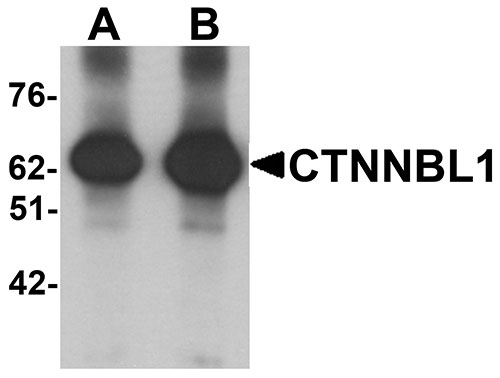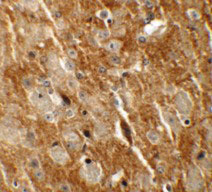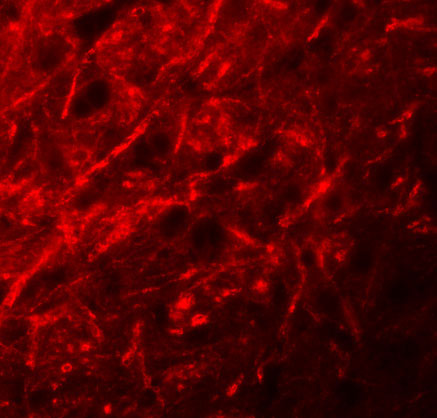CTTNBL1 Antibody
- 产品详情
- 实验流程
- 背景知识
Application
| WB, IF, E, IHC-P |
|---|---|
| Primary Accession | Q8WYA6 |
| Other Accession | NP_110517, 18644734 |
| Reactivity | Human, Mouse, Rat |
| Host | Rabbit |
| Clonality | Polyclonal |
| Isotype | IgG |
| Calculated MW | 65173 Da |
| Concentration (mg/ml) | 1 mg/mL |
| Conjugate | Unconjugated |
| Application Notes | CTTNBL1 antibody can be used for detection of CTTNBL1 by Western blot at 1 and 2 µg/mL. Antibody can also be used for immunohistochemistry starting at 5 µg/mL. For immunofluorescence start at 20 µg/mL. |
| Gene ID | 56259 |
|---|---|
| Other Names | Beta-catenin-like protein 1, Nuclear-associated protein, NAP, Testis development protein NYD-SP19, CTNNBL1, C20orf33 |
| Target/Specificity | CTNNBL1; CTNNBL1 antibody is predicted to not cross-react with other catenin family members. At least four isoforms of CTNNBL1 are known to exist; this antibody will detect all but isoform b. |
| Reconstitution & Storage | CTTNBL1 antibody can be stored at 4℃ for three months and -20℃, stable for up to one year. As with all antibodies care should be taken to avoid repeated freeze thaw cycles. Antibodies should not be exposed to prolonged high temperatures. |
| Precautions | CTTNBL1 Antibody is for research use only and not for use in diagnostic or therapeutic procedures. |
| Name | CTNNBL1 |
|---|---|
| Synonyms | C20orf33 |
| Function | Component of the PRP19-CDC5L complex that forms an integral part of the spliceosome and is required for activating pre-mRNA splicing. Participates in AID/AICDA-mediated somatic hypermutation (SHM) and class-switch recombination (CSR), 2 processes resulting in the production of high-affinity, mutated isotype-switched antibodies (PubMed:32484799). |
| Cellular Location | [Isoform 1]: Nucleus. |
| Tissue Location | Widely expressed with highest levels in skeletal muscle, placenta, heart, spleen, testis and thyroid |
For Research Use Only. Not For Use In Diagnostic Procedures.
Provided below are standard protocols that you may find useful for product applications.
BACKGROUND
CTTNBL1 Antibody: The Beta-catenin-like protein 1 (CTNNBL1) contains an acidic domain, a putative bipartite nuclear localization signal, a nuclear export signal, a leucine-isoleucine zipper, and phosphorylation motifs, as well as Armadillo/beta-catenin-like repeats. Transient expression of CTNNBL1 resulted in translocation to the nucleus and apoptosis, suggesting it may be involved in the apoptotic pathway. CTNNBL1 interacts with the Prp19 complex of the spliceosome and the Ig class switching enzyme activation-induced deaminase (AID) and had been suggested to play a role in antibody-diversification and class switching, but recent studies have shown CTNNBL1 to be dispensable for Ig class switch recombination. Other studies have identified CTTNBL1 as a novel gene for obesity.
REFERENCES
Jabbour L, Welter JF, Kollar, et al. Sequence, gene structure, and expression pattern of CTNNBL1, a minor-class intron-containing gene - evidence for a role in apoptosis. Genomics 2003; 81:292-303.
Conticello SG, Ganesh K, Xhu K, et al. Interaction between antibody-diversification enzyme AID and spliceosome-associated factor CTNNBL1. Mol. Cell 2008; 31:474-84.
Han L, Masani S, and Yu K. Cutting edge: CTNNBL1 is dispensable for Ig class switch recombination. J. Immunol. 2010; 185:1379-81.
Liu YJ, Liu XG, Wang L, et al. Genome-wide association scans identified CTNNBL1 as a novel gene for obesity. Hum. Mol. Genet. 2008; 17:1803-13.
终于等到您。ABCEPTA(百远生物)抗体产品。
点击下方“我要评价 ”按钮提交您的反馈信息,您的反馈和评价是我们最宝贵的财富之一,
我们将在1-3个工作日内处理您的反馈信息。
如有疑问,联系:0512-88856768 tech-china@abcepta.com.























 癌症的基本特征包括细胞增殖、血管生成、迁移、凋亡逃避机制和细胞永生等。找到癌症发生过程中这些通路的关键标记物和对应的抗体用于检测至关重要。
癌症的基本特征包括细胞增殖、血管生成、迁移、凋亡逃避机制和细胞永生等。找到癌症发生过程中这些通路的关键标记物和对应的抗体用于检测至关重要。 为您推荐一个泛素化位点预测神器——泛素化分析工具,可以为您的蛋白的泛素化位点作出预测和评分。
为您推荐一个泛素化位点预测神器——泛素化分析工具,可以为您的蛋白的泛素化位点作出预测和评分。 细胞自噬受体图形绘图工具为你的蛋白的细胞受体结合位点作出预测和评分,识别结合到自噬通路中的蛋白是非常重要的,便于让我们理解自噬在正常生理、病理过程中的作用,如发育、细胞分化、神经退化性疾病、压力条件下、感染和癌症。
细胞自噬受体图形绘图工具为你的蛋白的细胞受体结合位点作出预测和评分,识别结合到自噬通路中的蛋白是非常重要的,便于让我们理解自噬在正常生理、病理过程中的作用,如发育、细胞分化、神经退化性疾病、压力条件下、感染和癌症。








